The Ultimate Guide to Sales Strategy
Chapter 3
How to Build Winning Sales Proposals
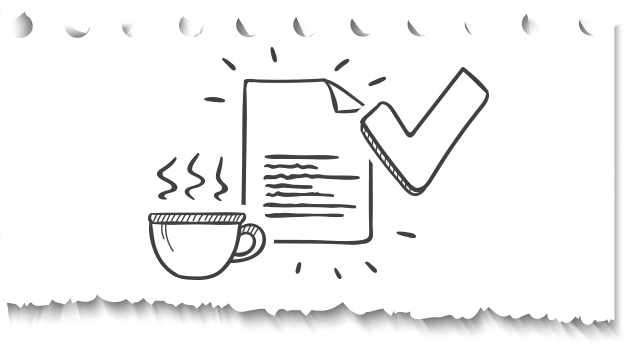
How to Build a Sales Proposal
You’ve got the sales mindset, pipeline structure, and now all you need is the skills. Obviously not the trade skills – we know you’ve got those – but the skill to communicate your company’s offering in a winning sales proposal.
Creating a sales proposal can be challenging for any business.
You may have many questions whirling around in your head: what makes it different from a quote or estimate? What should it include? What should it look like? How should it be sent?
Chapter 3 of The Ultimate Sales Tactics Guide for the Trades introduces you to the world of sales proposals and explains what you need to do to start building show-stopping proposals yourself.
What is a Sales Proposal?
Think of proposals as a written pitch to your prospects. They outline the service and/or product you’re offering in a clear and descriptive document that can be reviewed in the prospect’s own time. Typically, proposals represent the last step in the back-and-forth sales process and should be the final offering you make to a prospect, before you expect their decision.
Sales Proposals vs. Sales Quotes
Proposals are a more comprehensive alternative to a simple quote or estimate and should also demonstrate reasons why a prospect should pick your business for the job. Remember, yours is not the only quote or proposal that a prospect may receive for this work. This is your opportunity to make your business shine and for you to sell your company as the best solution over the competitors.

By including more than just the quoted price and a brief description, well-designed proposals can:
- Effectively display your brand and professionalism
- Showcase your dedication to great customer service
- Convey the quality of your services
- Highlight your business’s reputation and success
- Encourage sales of related products/services
- Make a strong, lasting impression
Proposals set the benchmark for the prospect’s expectations of your work and their interactions with your business, so it’s vital that you put your best foot forward. A slap-dash sales proposal or a quick quote may not send the best message to prospects about what they can expect from your services.
Building Beautiful Proposals with Sales Proposal Software
Now, with a clearer understanding of what a sales proposal is – and why proposals are different from quotes – the next logical question is ‘How do I build one?’.
Of course, like many modern challenges, the answer is with software. While you could opt for more generic tools for creating PDFs, documents, and presentations, you’ll soon find that a dedicated sales proposal software for tradespeople is more intuitive and will give you the best results.
Remember that the design is not the only important part of building a proposal. How much time and effort it takes your salespeople to build one, from inputting customer data to generating pricing tables, has a huge impact on your overall ability to make sales efficiently.
If the process is too drawn out and manual, you may find yourself wasting time and reducing the number of sales you make. With a sales proposal software designed specifically for trades businesses, you can expect to sync up parts and prices, create proposal templates for different work, and ensure that a profitable sales proposal is quick to both build and send.
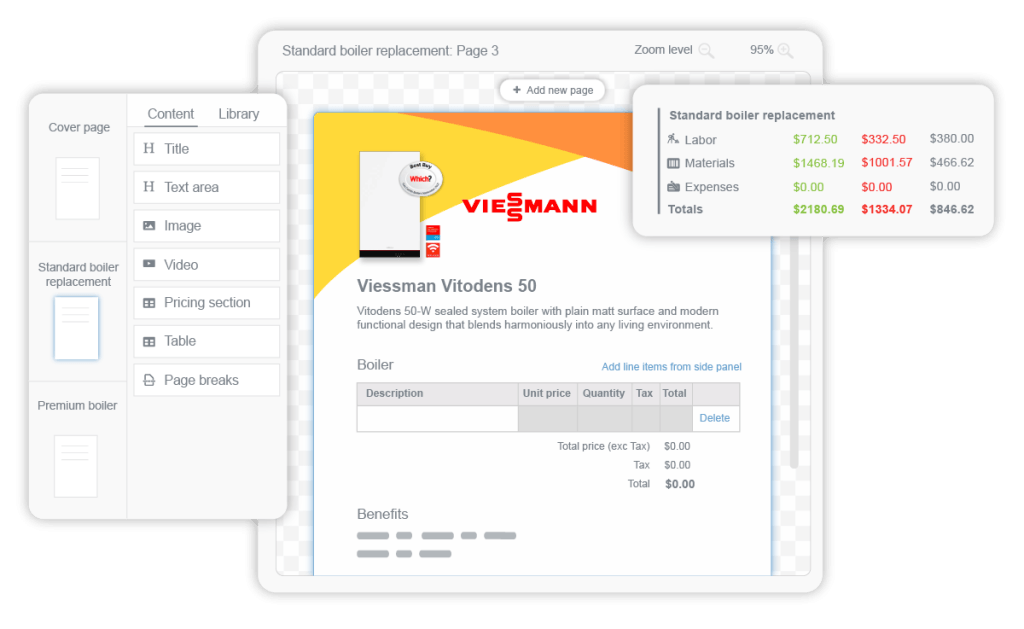
Let’s take a deeper look at what exactly you should plan to include in your sales proposals.
What Should a Sales Proposal Include?
Each section of your proposal functions to convince the prospect to choose you. While proposals can vary across different trades, jobs, and workflows, we’ve included a fairly standard proposal template below.
A Winning Proposal Includes a:
- Cover page
- Company overview
- Job specifications and options
- Add-ons
- Next steps
1. Cover Page
The cover of your proposal is where your company branding shines. Take the opportunity to use your logo and branding, make your company name overtly clear, and perhaps some relevant images and photography too. Take a look at these examples of sales proposal template covers, below:
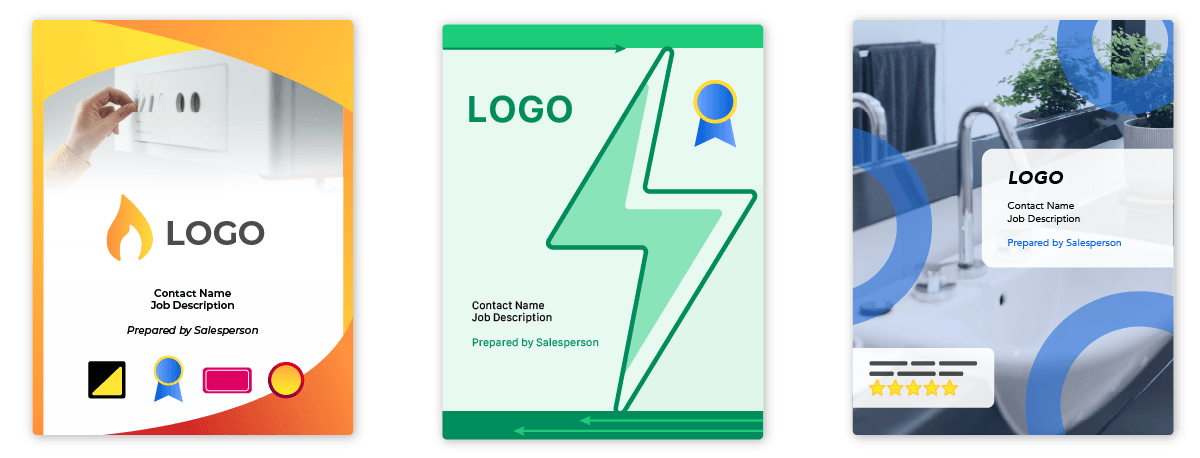
While your prospect is already familiar with your company at this stage, remaining recognizable and having a strong visual impact is still important. After all, prospects may be reviewing proposals from multiple trades businesses, so it’s key that your company continues to stand out with a professional cover page that screams your branding.
If somebody looks at the cover for 5 seconds and can’t tell you the company name, you’ve got a problem.
By including the prospect’s name and the title of the job or type of work, the proposal is personalized to them and shows that this is not just a generic, churned out document that you send to everyone. Research shows that personalization can be impactful, with businesses that use personalization techniques seeing a 19% increase on average in their sales.
Make Sure Your Cover Pages Includes:
- Company name
- Logo and branding
- Website address and phone number
- Prospect’s name and the proposed job type
Tips for a Great Cover Page
- Make sure that your branding, design, and logo look professional (we’d recommend using a design company if your branding needs a refresh!)
- Match the design to your website for a cohesive experience
- Keep it simple and digestible; don’t overdo it with too many images, different fonts, or contrasting colors. You want your cover page to say “business”, not “busy”.
Curious to learn more about design?
Listen to our Podcast: Take Stock! and Discover How Great Design Boosts Sales!
2. Company Overview
You don’t have to rush to the job-specific details on the first page of your sales proposal. This is your chance to share a bit more about your business and to try and differentiate yourself from competitors first.
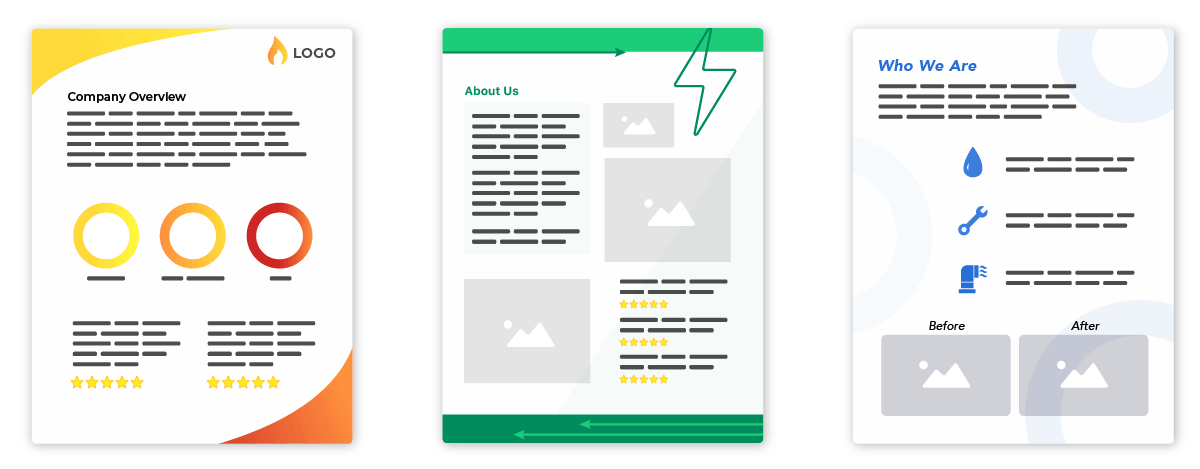
Exactly what you include will depend on your brand’s personality, company size, and your intended audience. There’s no right, or wrong method, per se; it’s about what works best for your trades business.
Try thinking about your future customers; what can you share with them that will win their trust?
Maybe they’d appreciate client testimonials and reviews or perhaps before-and-after photos of completed jobs. Building trust and establishing expertise through insights into your business makes it easier for prospects to commit to working with you.
Your Company Overview Could Include:
- A brief company history
- Something that sets you apart from competitors (your USP, if you have one)
- Your areas of expertise
- Social proof, such as testimonials from relevant clients and jobs
- Before-and-after photos of your work (bonus if they match the proposed work)
- Your team’s qualifications and accreditations
Social Proof
Reviews or testimonials; social proof is evidence given by customers about their experience of your services. Prospective customers will be on the lookout for social proof to help them make buying decisions.Tips for Promoting Your Company
- Is your company family-run? This can be a big selling point for new customers
- How long have you been in business? Longevity and experience are big sellers. If you’re a newer business, you might want to skip including that
- How much experience does your team have? Try adding up each technician’s years of experience e.g. “With 80 years of experience between us…”
- Do you have any well-known clients you could highlight? e.g. worked for a local star athlete or a chain of successful restaurants? Could they write you a testimonial or review?
- Can you include how many services or installations you’ve completed? e.g. “With over 1,000 HVAC units installed…”
3. Job Specifications and Options
Once you’ve highlighted your company, it’s time to focus on your future customer’s needs and how exactly you plan to help them. This is where you show that your team truly listened during the site survey.
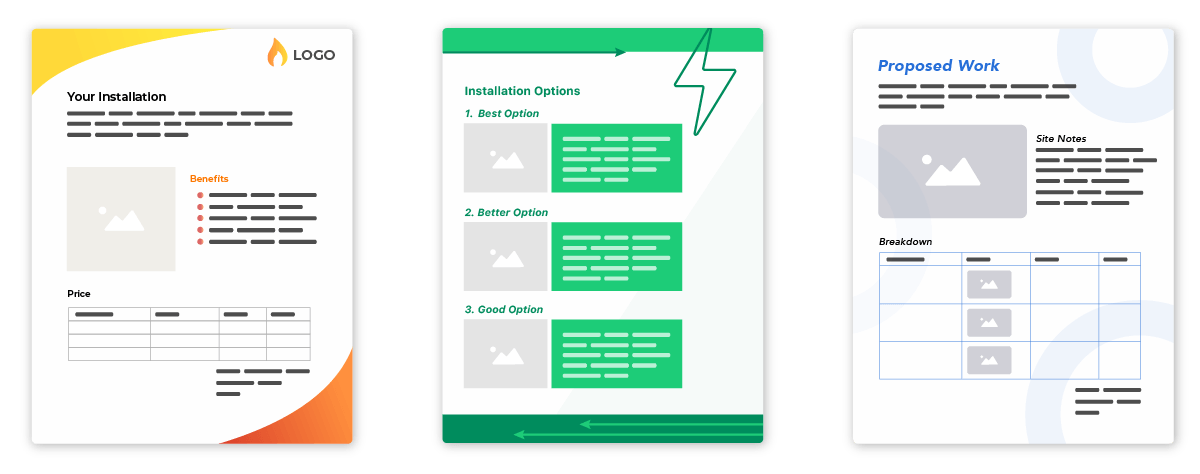
Demonstrate your knowledge by adding job notes or specifications centered around what the prospect asked for and what the surveyor assessed. Yes, this can take more time when preparing a sales proposal, but keep this in mind: personalization and attention to detail wins deals.
Don’t forget, this isn’t just a factual list of things you are offering. You still need to sell your proposed job and any options that prospects can pick from. Why would they want that appliance or that service?
Job Specifications Should:
- Reiterate what the prospect originally wished to achieve
- Outline what the proposed work entails
- Specify any appliances to be installed
- Have multiple options for the prospect to choose from
- Include price breakdown of parts, labor, and taxes
- Bonus: Offer the prospect a service contract for their new appliance
Why You Should Offer Multiple Options
It’s all a matter of math and psychology. Simple mathematics tells us that when you provide multiple options, you increase your chances of presenting a winning solution to your prospect. If you’re not totally sure what they’ll go for, three options are better than putting all your eggs in one basket. While it’s best to give the prospect a variety of recommendations, try not to overwhelm them. We recommend three options at a maximum.

By tiering three successively more expensive options as good ($), better ($$), best ($$$), you can better target a variety of budgets. This gives you an opportunity to upsell the prospect to something a little more expensive than they may have initially chosen. Don’t worry about putting people off. If your prospect is heavily driven by price, they will still have the cheapest option available to them.
Research shows that many people when faced with a range of prices don’t like to simply pick the cheapest. This is where psychology comes in.
‘Center Stage’ pricing is a pricing strategy based on the idea that buyers prefer to pick the middle option.
Meanwhile, ‘Price Anchoring’ is the theory that when presented with the most expensive option first, buyers will consider subsequent options to be better value for money.
Combine the two and you may be able to consistently close higher value jobs than if you were only offering the prospect one option.
Upselling
To upsell a customer is to convince them to make an additional purchase, or choose a more expensive option, than they initially requested.Tips to Improve Your Job Specification and Options
- Anticipate and answer any frequently asked questions
- Include site photos from the survey to further personalize the proposal
- List product details for each appliance from the product brochure or website.
- Including images, technical performance information, energy ratings, warranties etc. can be very persuasive.
- Embed a short personalized video outlining your recommendations – or perhaps a product overview video from the appliance manufacturer
4. Add-Ons
You’ve laid out the different options and what they involve in your sales proposal, but that doesn’t mean it’s time to stop selling. Add-ons are optional extras that prospects can choose to include or leave out of the deal and can be a fantastic source of additional revenue for your business.
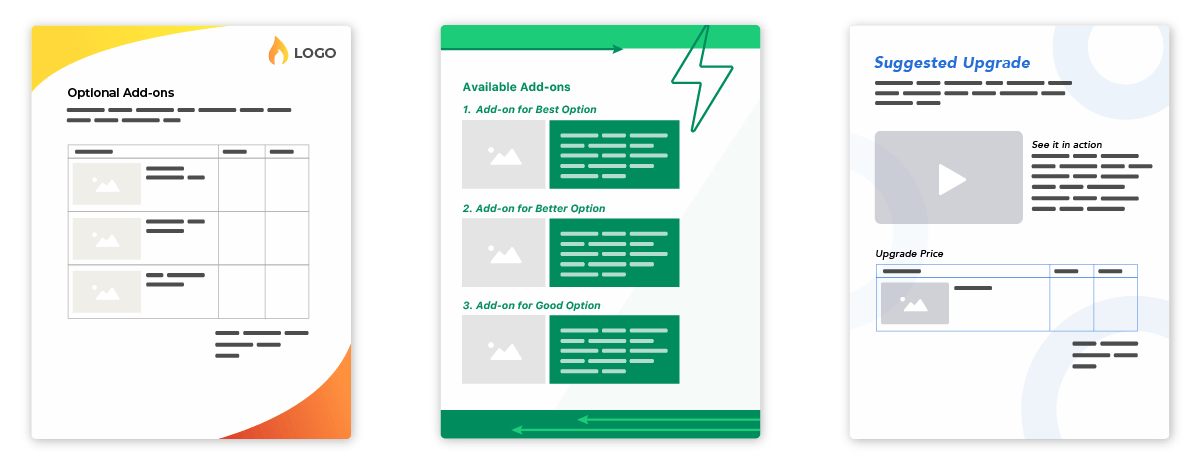
Just like offering multiple options, add-ons are simply basic math and psychology as well.
On the mathematics side, sales budgeting software can help your team incorporate add-ons that will allow you to increase the ticket value of each option you offer, without increasing the lowest price presented. This means that budget-focused customers can simply leave the add-on out and still get the same great price, while those looking for a premium offering have ways to get more (and spend more).
Option 1: $500
Add-On: +$150
Option 2: $650
Add-On: +$150
Option 3: $800
Add-On: +$150
There’s psychology to the idea of add-ons too.
When you think of ‘Impulse buying’ you may be reminded of getting in line at the grocery store and impulsively adding a Snickers bar to your basket, but the basic principle applies to any buying scenario. Many buyers will want or at least be open to additional services and products (especially when you are communicating clearly why they need them), but they may not have explicitly asked for these from the start.
For example, when selling a new boiler, you could offer a power flush or smart thermostat as an optional add-on. Any buyers that were on the fence might not be able to resist once it’s in front of them – helping you increase your bottom line.
Tips for Better Add-Ons
- Make them relevant and a logical addition to the options on offer. You may need to offer different add-ons for different options if they are drastically different products/services.
- Consider a small discount to encourage impulse buying and help prospects feel like they are getting a deal if they act now.
- Sell them well. Include descriptors, benefits, and images to make add-ons as attractive as possible.
5. Next Steps
You’ve provided an enticing and branded cover page, outlined your services, explained how your team can best help the prospective customer, and detailed different options and add-ons; now it’s time to wrap up with clear and actionable next steps.
At this point, it’s important to understand that prospects may be at different steps in their decision-making.
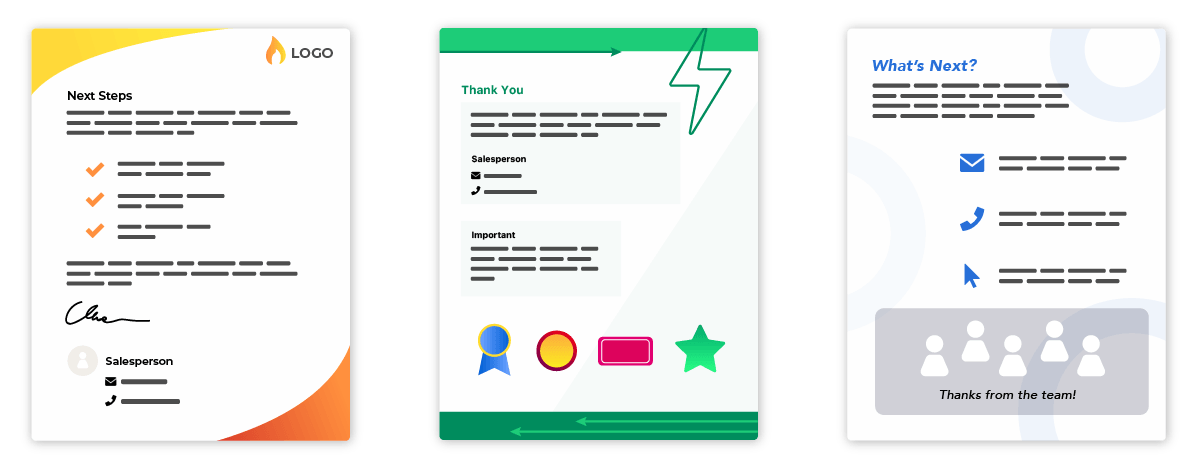
Some will still be evaluating competitors and may have additional questions, while others may be ready to move ahead right away. Make sure that you provide information that will be useful no matter where your prospect is in their own decision-making process. Your goal is to provide actionable next steps and make yourself approachable for any follow-ups, all while setting a sense of urgency to encourage the prospect to make a decision.
Unknowns can be scary. Get this final page right and your prospects should have no doubt as to what comes next if they choose to work with your business.
What to Include in Your Next Steps:
- The salesperson’s phone number and email address, with a prompt to get in touch if they have any questions
- Clear instructions on how to accept the proposal (such as by phone, email, or via an online portal)
- An expiry date or time frame for accepting e.g. “This proposal is valid for 30 days.”
- An idea of the current waiting time for such work, if possible. This gives the prospect clear expectations.
- An outline of what to expect once they accept e.g. “As soon as your proposal is accepted and the deposit paid, we’ll order the necessary parts and reach out to arrange the exact day that the work will be completed.”
Use an Online Proposal Portal
To give customers the best possible experience, you want to provide an intuitive and convenient way for them to review and accept your proposal. This not only makes it crystal clear for customers as to what they are accepting (and the options or add-ons they have chosen), but it reduces friction in the process too.
A self-service proposal portal means that at any time of day or night, customers can action your sales proposal, make their various choices, pay a deposit, and even apply for financing too – all without calling or emailing your busy team.
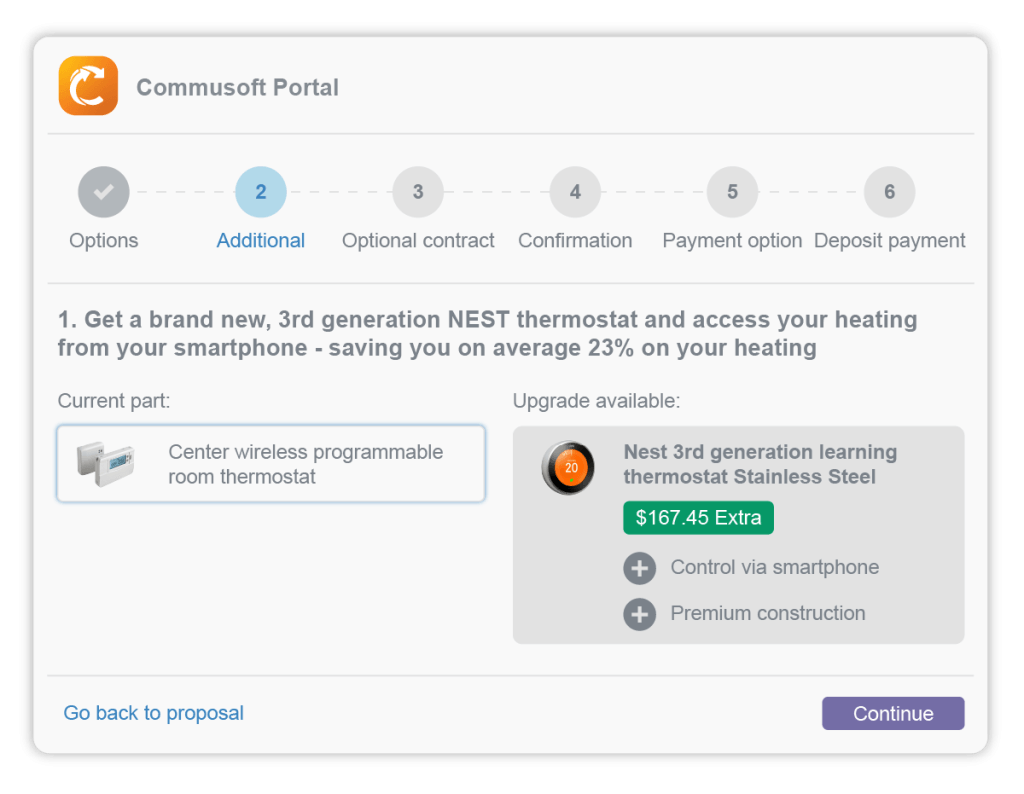
Of course, some customers will prefer to call in and run through their proposal with you before accepting. But for many, a more convenient option that’s available 24/7 will be just what they are looking for – and is sure to impress!
And there you have it: a winning sales proposal from start to finish!
Question
How important is the appearance of the documents you send to prospects?
We totally agree! The quality of the documents you send says a lot about your business – and the reality is many people will judge a book by its cover. That’s why your proposals need to stand out from the crowd and work to win over your potential customers. Looking for a design company to help make your documents shine? Check out some of our design partners.
Okay! Most likely you consider your documents as transactional – their purpose is to communicate a price and that’s it. However, the documents you share will absolutely impact the perception your prospects have and their decision to do (or not do) business with you. After all, people will judge books by their cover. Revisit this chapter or watch our video on building trust to learn more.






